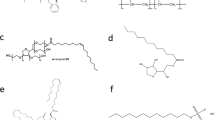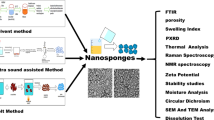Abstract
Methyl cellulose (MC) based nasal in situ gels were developed to enhance the brain delivery of piribedil (PBD), an anti-Parkinson’s drug. Different grades of MC and several solutes (NaCl, KCl, Na.Citrate, STPP, PEG-6000, sucrose, etc.) were screened to formulate thermo-responsive nasal in situ gelling systems. Formulations were evaluated for their sol-gel transition temperature and time, rheological behaviour, in vitro drug release, mucociliary clearance (MCC), ex vivo nasal toxicity, and in vivo brain availability studies in Wistar rats. Intranasal (i.n.) administration was carried out using a cannula-microtip setup to deliver PBD at the olfactory region of the nose. The concentration and viscosity grade of MC and also the concentration and type of solute used were found to affect the rheological behaviour of the formulations. Among the solutes tested, NaCl was found to be effective for formulating MC in situ gels. The developed in situ gels significantly delayed the MCC of PBD from the site of administration when compared with conventional suspension (p < 0.05). Further, formulations with higher gel strength showed lower in vitro drug release rate and longer intranasal residence (delayed MCC) (p < 0.05). The absolute brain availability (brain AUC0-t) of PBD increased to 35.92% with i.n. delivery when compared to 4.71% with oral administration. Overall, it can be concluded that intranasal delivery of PBD is advantageous when compared to the currently practiced oral therapy.

Graphical abstract











Similar content being viewed by others
References
Türker S, Onur E, Ózer Y. Nasal route and drug delivery systems. Pharm World Sci. 2004;26:137–42.
Bitter C, Suter-Zimmermann K, Surbera C. Nasal drug delivery in humans. Top Appl Mucosa. Basel: KARGER; 2011. p. 20–35.
Illum L. Is nose-to-brain transport of drugs in man a reality? J Pharm Pharmacol. 2004;56:3–17.
Illum L. Intranasal Delivery to the central nervous system. In: Di L, Kerns EH, editors. Blood-Brain Barrier Drug Discov. Hoboken, NJ: John Wiley & Sons, Inc; 2015. p. 535–65.
Merkus FWHM, van den Berg MP. Can nasal drug delivery bypass the??Blood-brain barrier? Drugs R D. 2007;8:133–44.
Mittur A. Piribedil: Antiparkinsonian properties and potential clinical utility in dopaminergic disorders. Curr Drug Ther. 2010;6:17–34.
Deleu D, Northway MG, Hanssens Y. Clinical pharmacokinetic and pharmacodynamic properties of drugs used in the treatment of Parkinson’s disease. Clin Pharmacokinet. 2002;41:261–309.
Torti M, Bravi D, Vacca L, Stocchi F. Are all dopamine agonists essentially the same? Drugs. 2019;79:693–703.
Nodel MR, Obukhova AV, Yakhno NN. The efficacy of piribedil in the treatment of neuropsychiatric disorders at early stages of Parkinson’s disease. Nevrol Zhurnal Izdatel’stvo Meditsina. 2016;21:110–6.
Kaur P, Garg T, Rath G, Goyal AK. In situ nasal gel drug delivery: a novel approach for brain targeting through the mucosal membrane. Artif Cells Nanomed Biotechnol. 2016;44:1167–76.
Ravi PR, Aditya N, Patil S, Cherian L. Nasal in-situ gels for delivery of rasagiline mesylate: improvement in bioavailability and brain localization. Drug Deliv. 2015;22:903–10.
Zahir-Jouzdani F, Wolf JD, Atyabi F, Bernkop-Schnürch A. In situ gelling and mucoadhesive polymers: why do they need each other? Expert Opin Drug Deliv. Taylor & Francis. 2018;15:1007–19.
Inactive Ingredient Search for Approved Drug Products. [cited 2020 Mar 9]. Available from: https://www.accessdata.fda.gov/scripts/cder/iig/index.cfm?event=BasicSearch.page. Accessed 12 Nov 2019.
Jain S, Sandhu PS, Malvi R, Gupta B. Cellulose derivatives as thermoresponsive polymer: an overview. J Appl Pharm Sci. 2013;3:139–44.
Kundu P, Kundu M. Effect of salts and surfactant and their doses on the gelation of extremely dilute solutions of methyl cellulose. Polymer. 2001;42:2015–20.
Liu SQ, Joshi SC, Lam YC. Effects of salts in the Hofmeister series and solvent isotopes on the gelation mechanisms for hydroxypropylmethylcellulose hydrogels. J Appl Polym Sci. 2008;109:363–72.
Marzouk MA, Osman DA, Abd El-Fattah AI. Formulation and in vitro evaluation of a thermoreversible mucoadhesive nasal gel of itopride hydrochloride. Drug Dev Ind Pharm. 2018;44:1857–67.
Wang Y, Jiang S, Wang H, Bie H. A mucoadhesive, thermoreversible in situ nasal gel of geniposide for neurodegenerative diseases. PLoS One. 2017;12:1–17.
Gavini E, Rassu G, Ferraro L, Beggiato S, Alhalaweh A, Velaga S, et al. Influence of polymeric microcarriers on the in vivo intranasal uptake of an anti-migraine drug for brain targeting. Eur J Pharm Biopharm. 2013;83:174–83.
Mishra B, Sankar C, Mishra M. Polymer based solutions of bupranolol hydrochloride for intranasal systemic delivery. J Drug Target. 2011;19:204–11.
Pásztor E, Makó Á, Csóka G, Fenyvesi Z, Benko R, Prosszer M, et al. New formulation of in situ gelling metolose-based liquid suppository. Drug Dev Ind Pharm. 2011;37:1–7.
Bhowmik M, Das S, Chattopadhyay D, Ghosh LK. Study of thermo-sensitive in-situ gels for ocular delivery. Sci Pharm. 2011;79:351–8.
Bain MK, Bhowmik M, Maity D, Bera NK, Ghosh S, Chattopadhyay D. Control of thermo reversible gelation of methylcellulose using polyethylene glycol and sodium chloride for sustained delivery of ophthalmic drug. J Appl Polym Sci. 2010;118:631–7.
Bhowmik M, Bain MK, Ghosh LK, Chattopadhyay D. Effect of salts on gelation and drug release profiles of methylcellulose-based ophthalmic thermo-reversible in situ gels. Pharm Dev Technol. 2011;16:385–91.
Quadir M, Zia H, Needham TE. Toxicological implications of nasal formulations. Drug Deliv J Deliv Target Ther Agents. 1999;6:227–42.
Sangfai T, Tantishaiyakul V, Hirun N, Li L. Microphase separation and gelation of methylcellulose in the presence of gallic acid and NaCl as an in situ gel-forming drug delivery system. AAPS PharmSciTech. 2017;18:605–16.
Uppuluri CT, Dalvi AV, Bommireddy EP, Ravi PR. Development and validation of rapid and sensitive LC methods with PDA and fluorescence detection for determination of piribedil in rat plasma and brain tissues and their pharmacokinetic application. Biomed Chromatogr. 2018;32:1–10.
Charlton ST, Davis SS, Illum L. Evaluation of bioadhesive polymers as delivery systems for nose to brain delivery: in vitro characterisation studies. J Control Release. 2007;118:225–34.
Javia A, Thakkar H. Intranasal delivery of tapentadol hydrochloride–loaded chitosan nanoparticles: formulation, characterisation and its in vivo evaluation. J Microencapsul Taylor & Francis. 2017;34:644–58.
Lale AM, Mason JDT, Jones NS. Mucociliary transport and its assessment: a review. Clin Otolaryngol Allied Sci. 1998;23:388–96.
Mittal D, Ali A, Md S, Baboota S, Sahni JK, Ali J. Insights into direct nose to brain delivery: current status and future perspective. Drug Deliv. 2014;21:75–86.
Fairclough JPA, Yu H, Kelly O, Ryan AJ, Sammler RL, Radler M. Interplay between gelation and phase separation in aqueous solutions of methylcellulose and hydroxypropylmethylcellulose. Langmuir. 2012;28:10551–7.
Weng L, Chen X, Chen W. Rheological characterization of in situ crosslinkable hydrogels formulated from oxidized dextran and N-carboxyethyl chitosan. Biomacromolecules. 2007;8:1109–15.
Fakhari A, Corcoran M, Schwarz A. Thermogelling properties of purified poloxamer 407, vol. 3. Heliyon: Elsevier Ltd.; 2017. p. e00390.
Freitas MN, Farah M, Bretas RES, Ricci E, Marchetti JM. Rheological characterization of Poloxamer 407 nimesulide gels. Rev Ciencias Farm Basica Apl. 2006;27:113–8.
Mathematical models of drug release. Strateg to Modify Drug Release from Pharm Syst. Elsevier; 2015. p. 63–86.
Principi N, Esposito S. Nasal irrigation: an imprecisely defined medical procedure. Int J Environ Res Public Health. 2017;14:516.
Baraniuk JN, Ali M, Yuta A, Fang SY, Naranch K. Hypertonic saline nasal provocation stimulates nociceptive nerves, substance P release, and glandular mucous exocytosis in normal humans. Am J Respir Crit Care Med. 1999;160:655–62.
Bergmann C, Müller K, Thieme U, Zeman F, Huppertz G, Koller M, et al. Real-world data on the use of hypertonic saline nasal spray in ENT practice. SN Compr Clin Med. 2019;1:354–61.
Horváth T, Bartos C, Bocsik A, Kiss L, Veszelka S, Deli MA, et al. Cytotoxicity of different excipients on RPMI 2650 human nasal epithelial cells. Molecules. 2016;21:1–5.
Acknowledgments
Chandra Teja Uppuluri thanks Lady Tata Memorial Trust for awarding a Junior Research Scholarship to pursue his doctoral studies. The authors thank the Central Analytical Laboratory of BITS-Pilani, Hyderabad Campus, for providing HPLC-Fluorescence and Rheometer facilities.
Author information
Authors and Affiliations
Corresponding author
Ethics declarations
Conflict of interest
The authors declare that they have no conflict of interest.
Ethical approval
All procedures performed in studies involving animals were in accordance with the ethical standards of the institution at which the studies were conducted and ethical approval was obtained from institute animal ethics committee (IAEC), BITS-Pilani, Hyderabad Campus (Regn. No.: 1912/PO/RE/S/16/CPCSEA).
Additional information
Publisher’s note
Springer Nature remains neutral with regard to jurisdictional claims in published maps and institutional affiliations.
Rights and permissions
About this article
Cite this article
Uppuluri, C.T., Ravi, P.R., Dalvi, A.V. et al. Piribedil loaded thermo-responsive nasal in situ gelling system for enhanced delivery to the brain: formulation optimization, physical characterization, and in vitro and in vivo evaluation. Drug Deliv. and Transl. Res. 11, 909–926 (2021). https://doi.org/10.1007/s13346-020-00800-w
Published:
Issue Date:
DOI: https://doi.org/10.1007/s13346-020-00800-w




